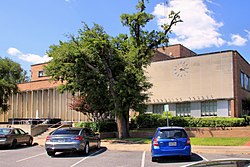Angelina County, Texas
| Angelina County, Texas | |
|---|---|

The Angelina County Courthouse in Lufkin
|
|
 Location in the U.S. state of Texas |
|
 Texas's location in the U.S. |
|
| Founded | 1846 |
| Named for | A Hasinai woman who assisted early Spanish missionaries and was named Angelina by them |
| Seat | Lufkin |
| Largest city | Lufkin |
| Area | |
| • Total | 865 sq mi (2,240 km2) |
| • Land | 798 sq mi (2,067 km2) |
| • Water | 67 sq mi (174 km2), 7.7% |
| Population | |
| • (2010) | 86,771 |
| • Density | 109/sq mi (42/km²) |
| Congressional district | 1st |
| Time zone | Central: UTC-6/-5 |
| Website | www |
Angelina County is a county located in the U.S. state of Texas. As of the 2010 census, the population was 86,771. Its county seat is Lufkin. The county was formed in 1846 from Nacogdoches County. It is named for a Hasinai Native American woman who assisted early Spanish missionaries and was named Angelina by them. Angelina County is a wet county as of November 2006 wet/dry election. In November 2007 the small community of Burke was the only city in Angelina county to return to dry status.
The Lufkin, TX Micropolitan Statistical Area includes all of Angelina County.
The county's first Anglo settlers were what John Nova Lomax described as "Scotch-Irish backwoods folk." Cotton farmers and slaves did not come to Angelina County because it had poor soil. Lomax added that "Culturally, the county was less moonlight-and-magnolias Dixie than a little pocket of Appalachia, where pioneers, often from similarly hardscrabble areas of Georgia, Alabama and Mississippi, wanted nothing more than to carve homesteads out of the Piney Woods and river thickets, farm a little, maybe raise a scraggly herd of tough cattle to drive to market in New Orleans." Lomax added that "[t]hey also wanted to brew up a little whiskey and subsist on the bass, catfish and perch they hauled from the Neches and Angelina rivers and whatever they could trap and shoot on dry land."
Settlement was still thin when Texas won its independence. Angelina County was organized on April 22, 1846, when Nacogdoches County was divided. The first permanent settler after the county was formed is thought to have been George W. Collins. The population increased quickly thereafter due to the good farming land and to the rivers, which made steamboat transportation possible. The population reached 1,165, 196 of whom were slaves, in 1850. The first county seat was Marion; successively, Jonesville became county seat in 1854, Homer in 1858, and Lufkin in 1892. Lufkin was favored by the route of the Houston, East and West Texas Railway (now the Southern Pacific), which had been built in 1882 from Houston to Shreveport.
...
Wikipedia
